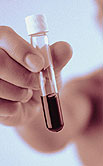Testing rates of those ages 15 to 44: 22 percent for females and 16 percent for males
TUESDAY, June 2, 2015 (HealthDay News) — Nearly one-fifth of teens and younger adults in the United States have been tested recently for HIV, federal health officials reported Tuesday.
Researchers at the U.S. Centers for Disease Control and Prevention’s National Center for Health Statistics analyzed data from 5,601 females and 4,815 males, ages 15 to 44, who took part in the 2011 to 2013 National Survey of Family Growth. The researchers found that 19 percent had undergone HIV testing in the past year, an increase from 17 percent in both 2002 and 2006 to 2010. HIV testing rates in 2011 to 2013 were 22 percent for females and 16 percent for males, compared with 20 percent for females in 2002.
Females ages 25 to 34 were most likely to have been tested (29 percent), followed by females ages 15 to 24 (22 percent) and those ages 35 to 44 (16 percent). Black females were more likely to have been tested (45 percent) than Hispanics (21 percent) or whites (16 percent). Among females ages 22 to 44, those with a high school diploma or less were more likely to have been tested (26 percent) than those with some college (25 percent) or those with a bachelor’s degree or higher (20 percent). Males ages 25 to 34 were more likely to have been tested (19 percent) than those ages 35 to 44 (13 percent) and those ages 15 to 24 (16 percent). Black males were more likely to have been tested (33 percent) than Hispanics (15 percent) or whites (13 percent). Education had little effect on rates of HIV testing among men.
Females who had same-sex contact in the past year were more likely to have been tested for HIV (35 percent) than those with any opposite-sex contact (approximately 25 percent). Slightly less than 40 percent of males who had any same-sex contact in the past year had been tested, compared with 20 percent who had any opposite-sex contact. Twenty-six percent of females who had vaginal intercourse or oral sex with a male were tested, compared with 18 percent of males who had vaginal or oral sex with a female. Rates of HIV testing were similar for females and males who had anal sex with an opposite-sex partner (25 and 23 percent, respectively), or any same-sex contact in the past year (35 and 38 percent, respectively).
Copyright © 2015 HealthDay. All rights reserved.








